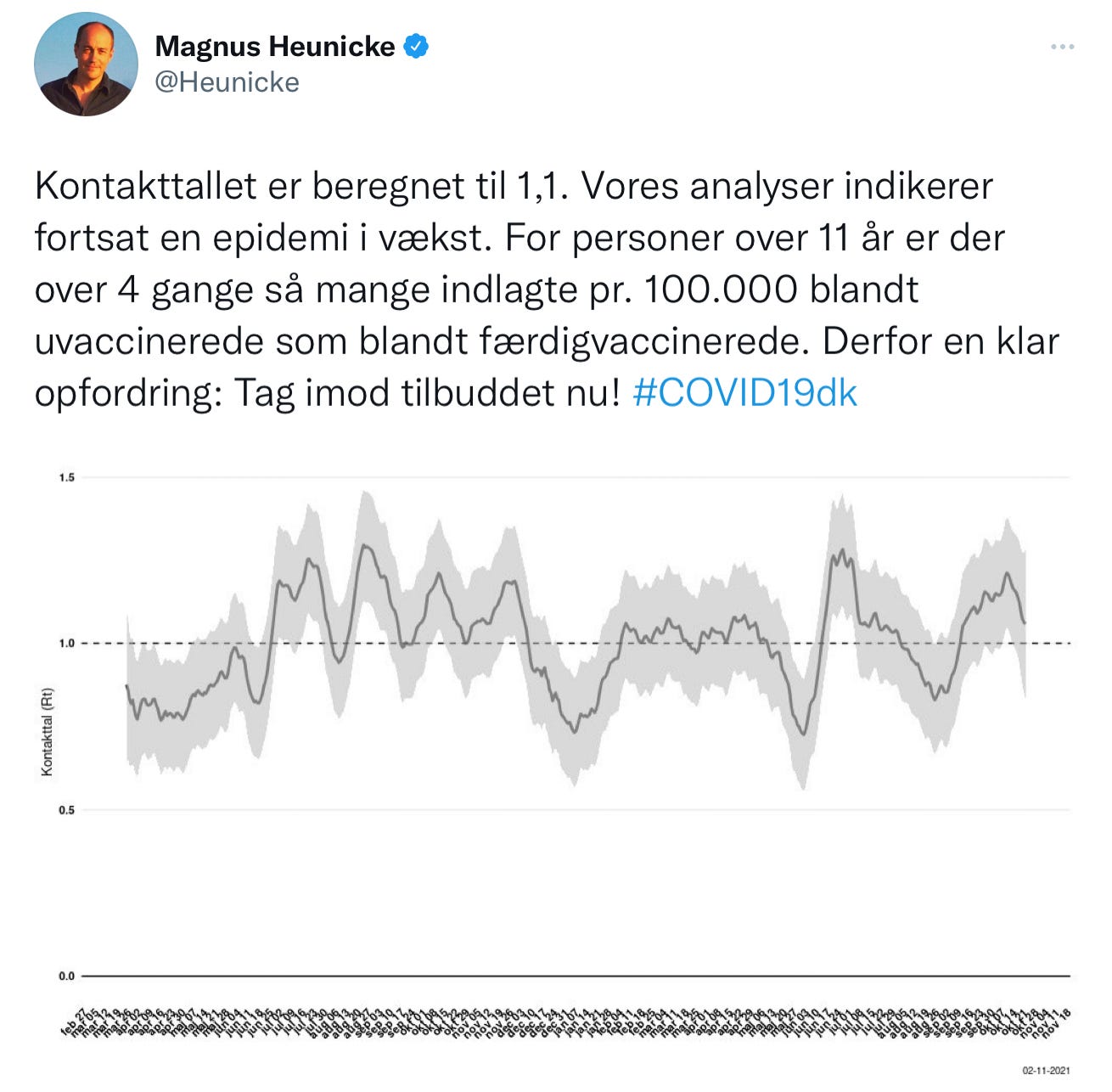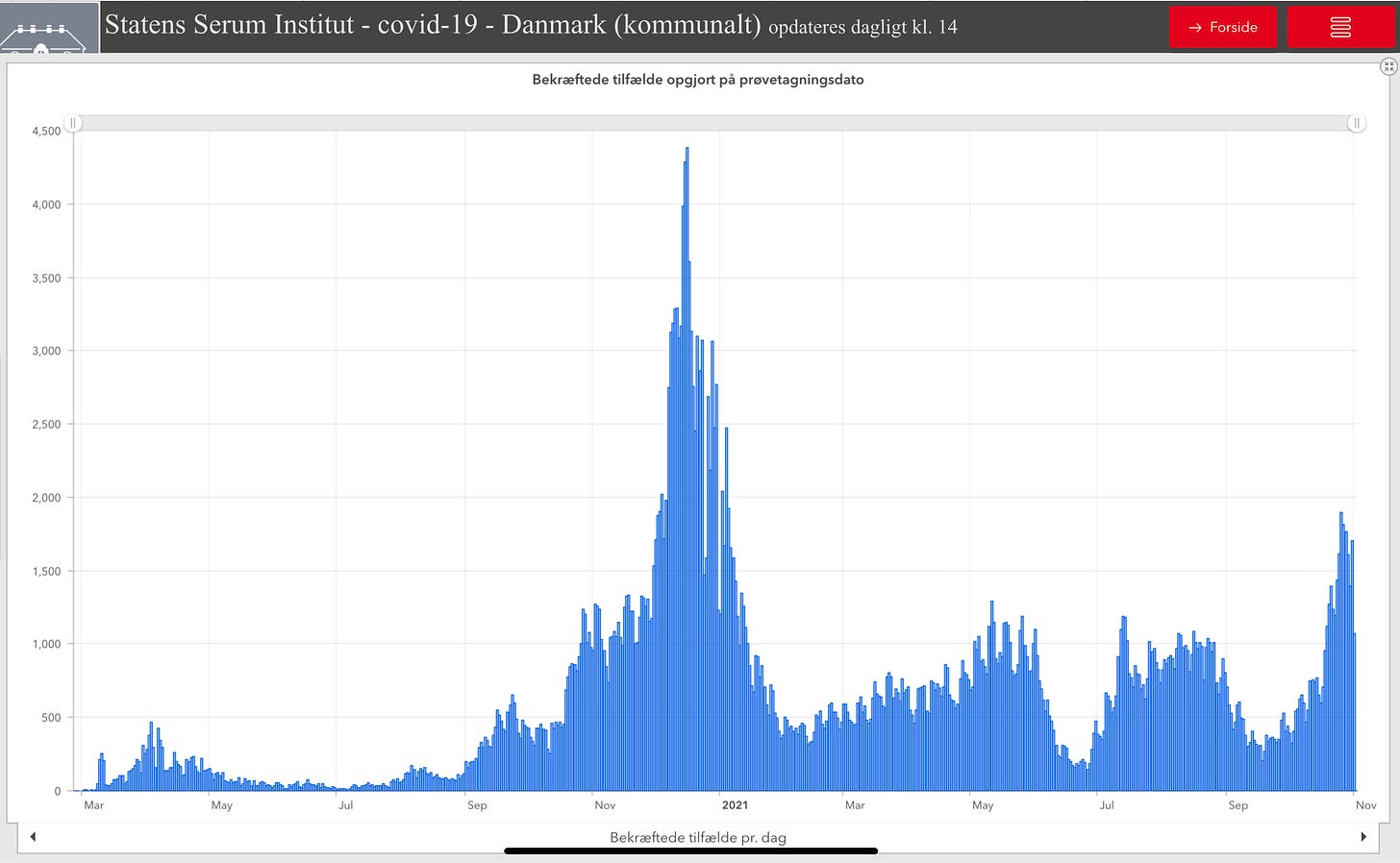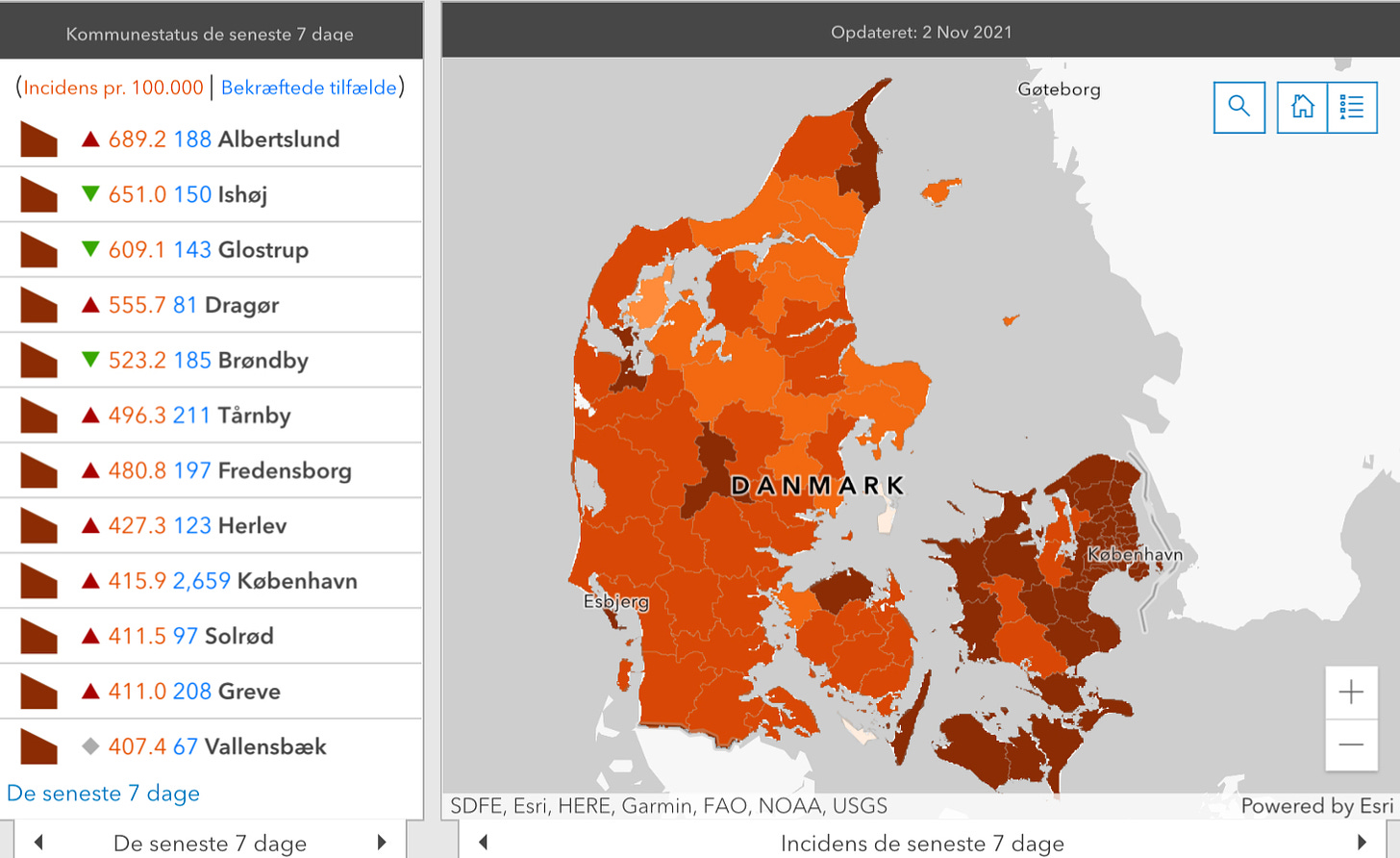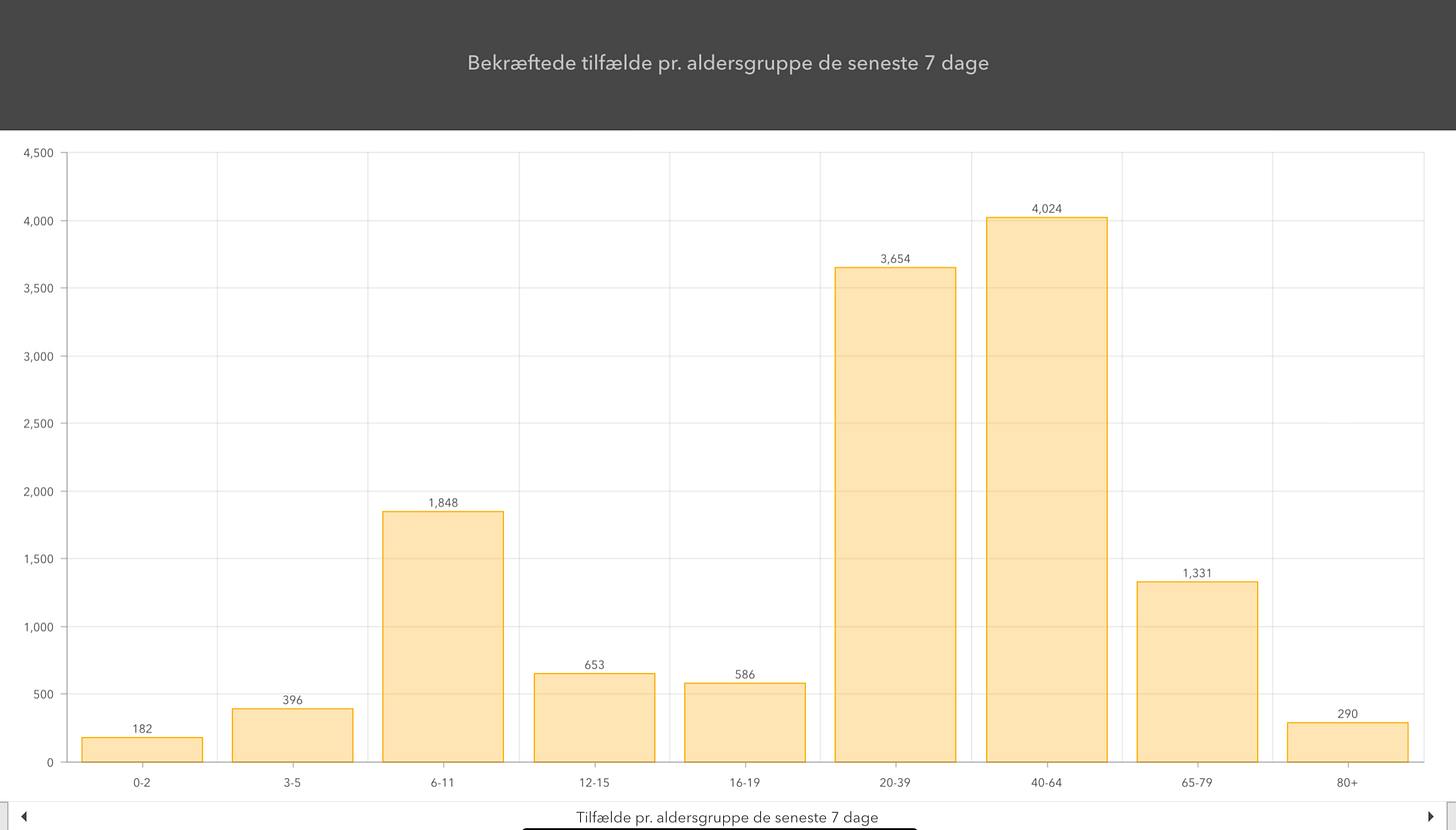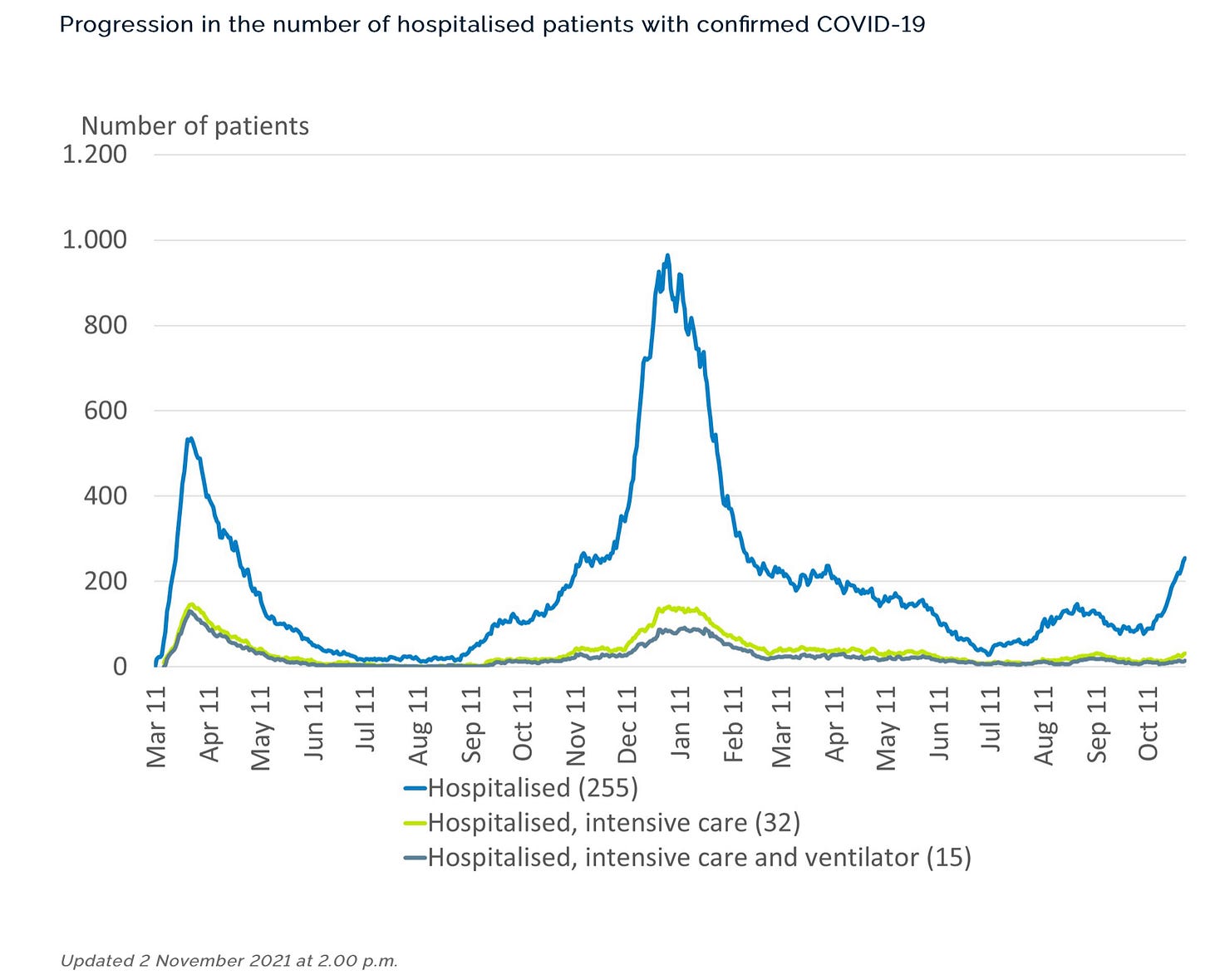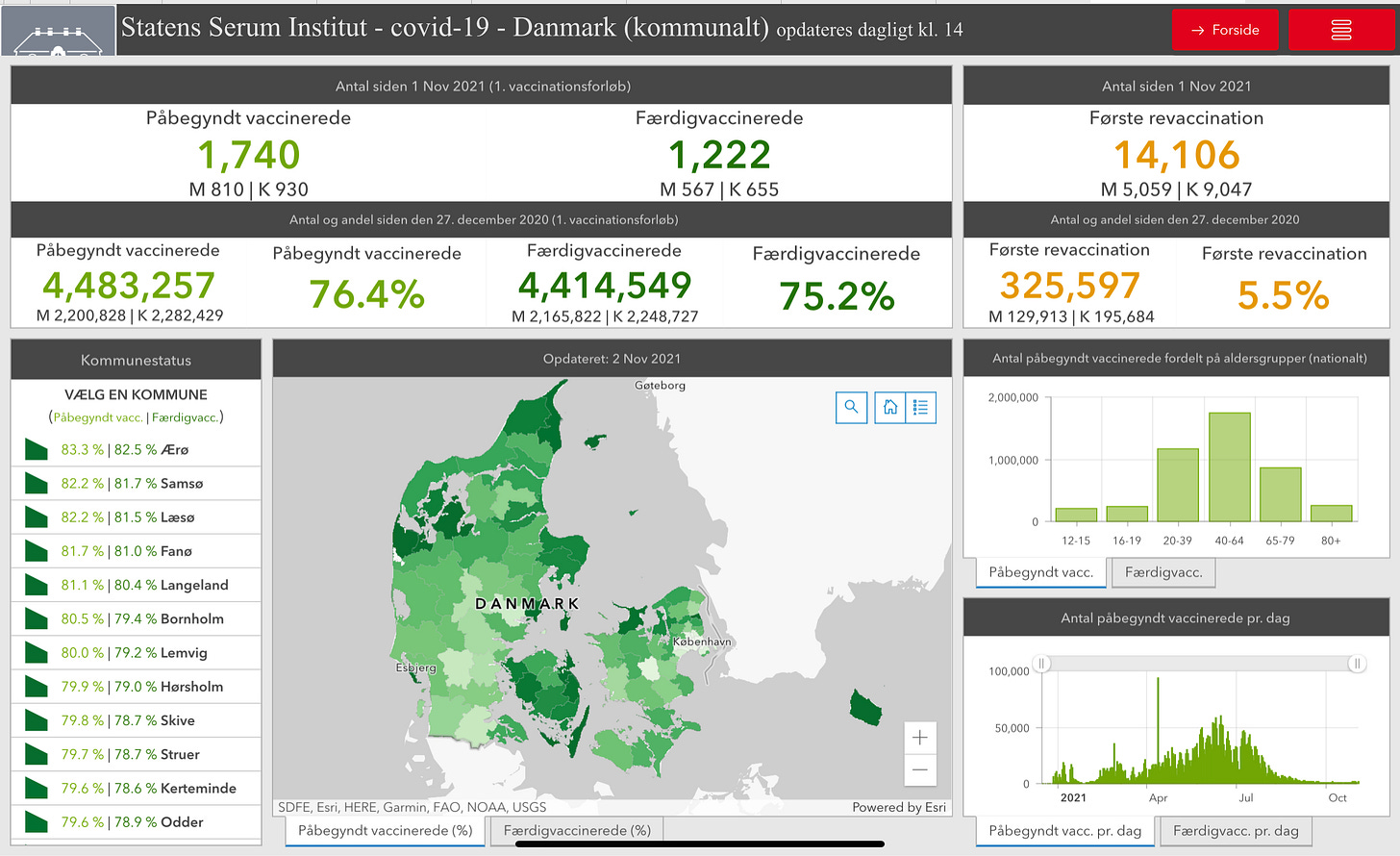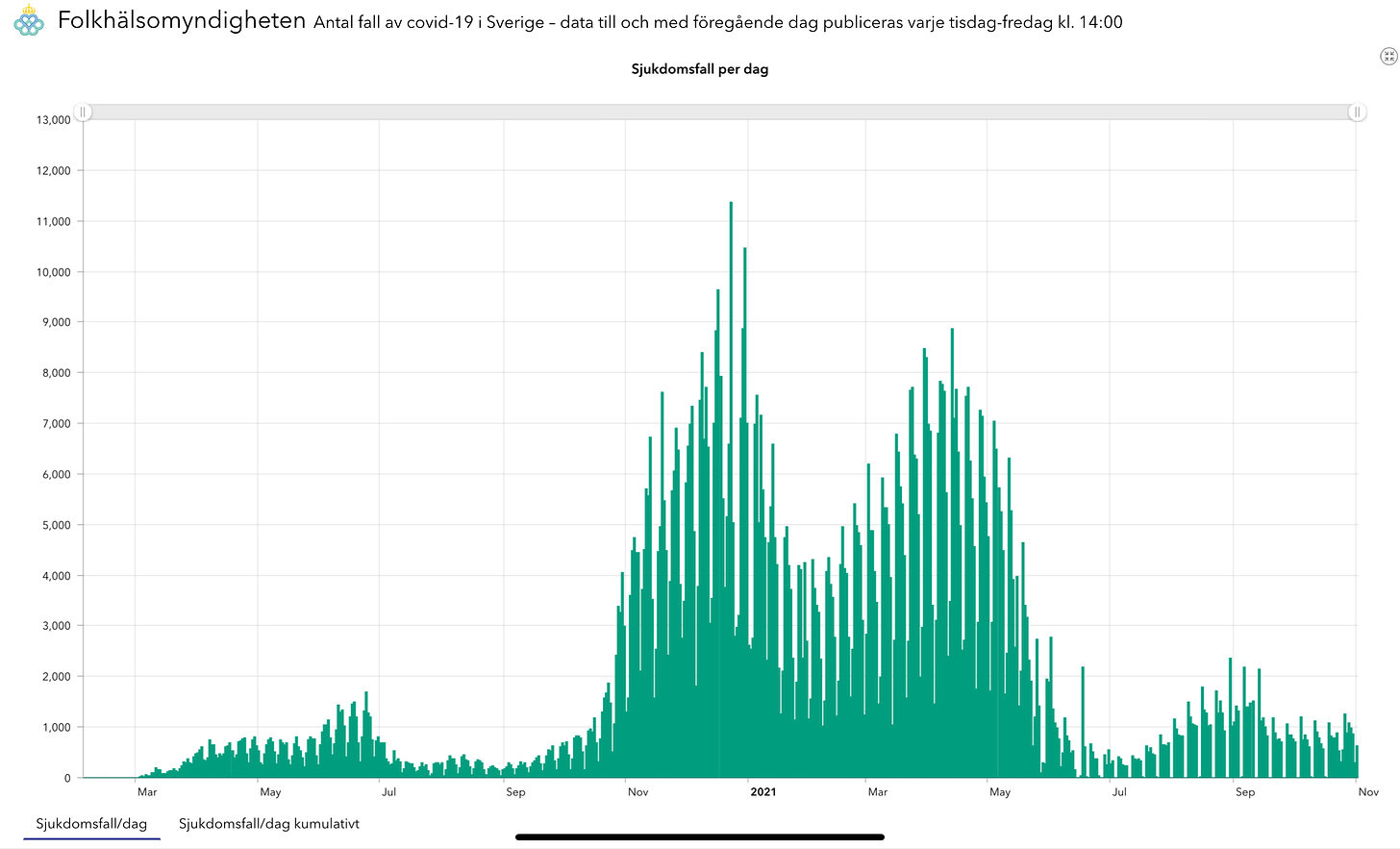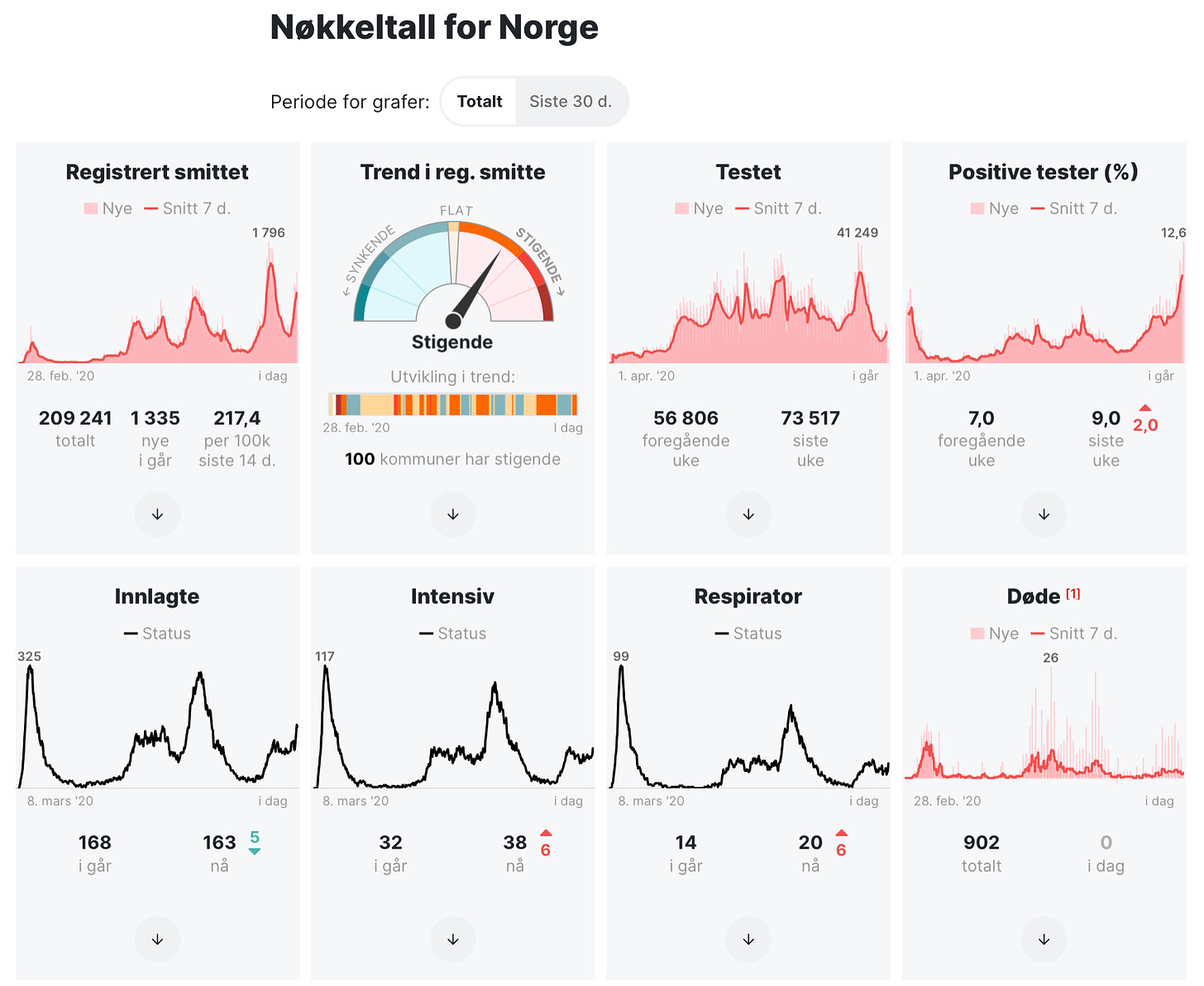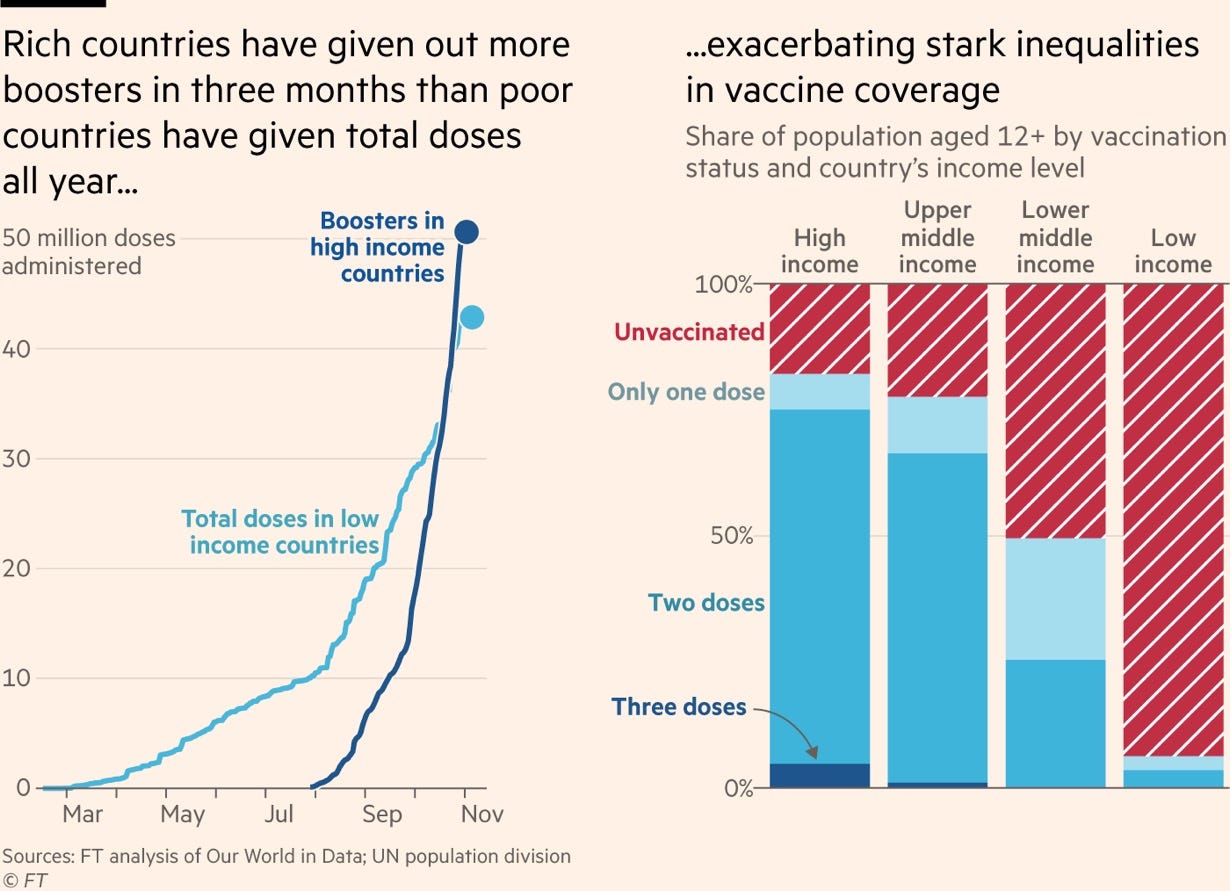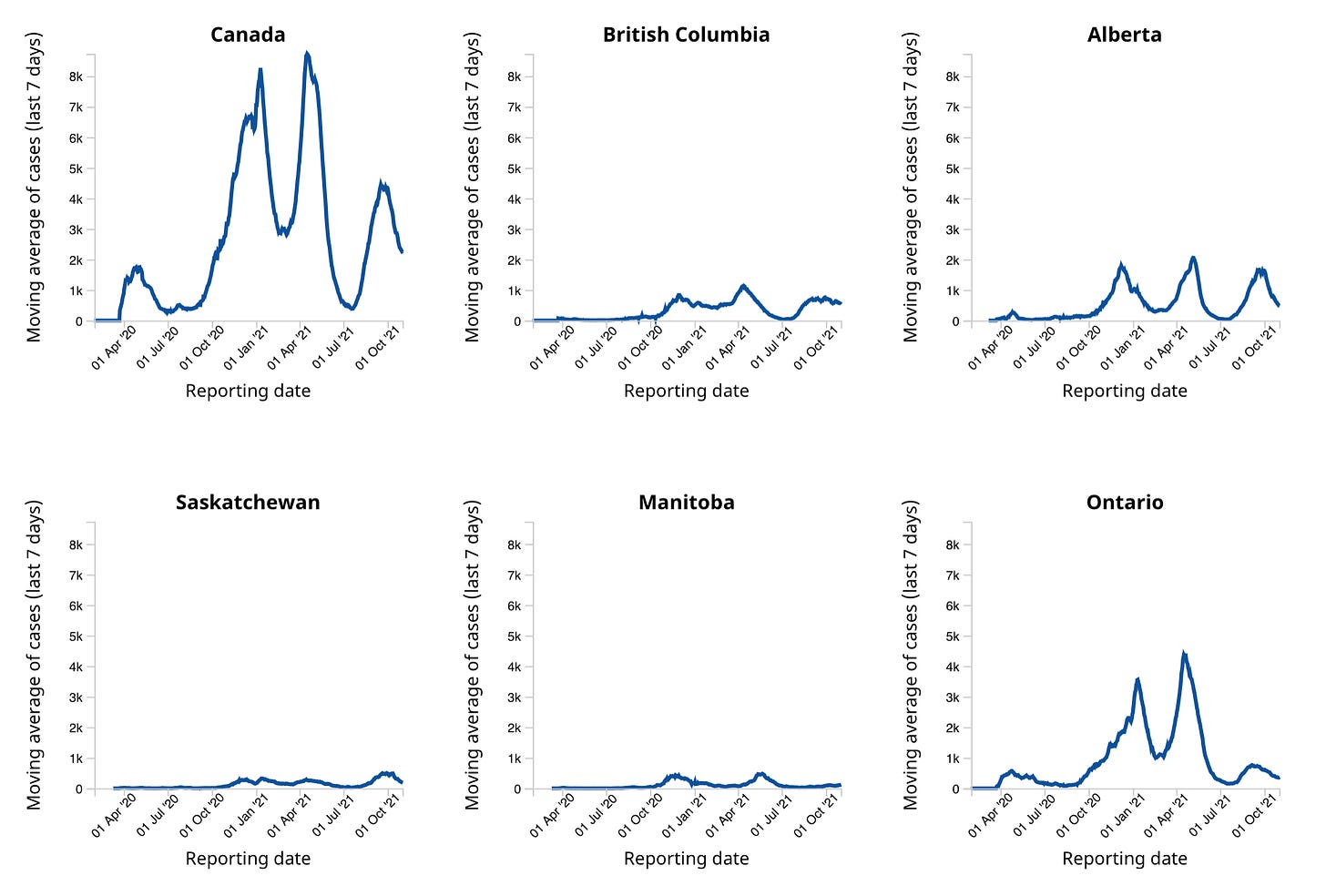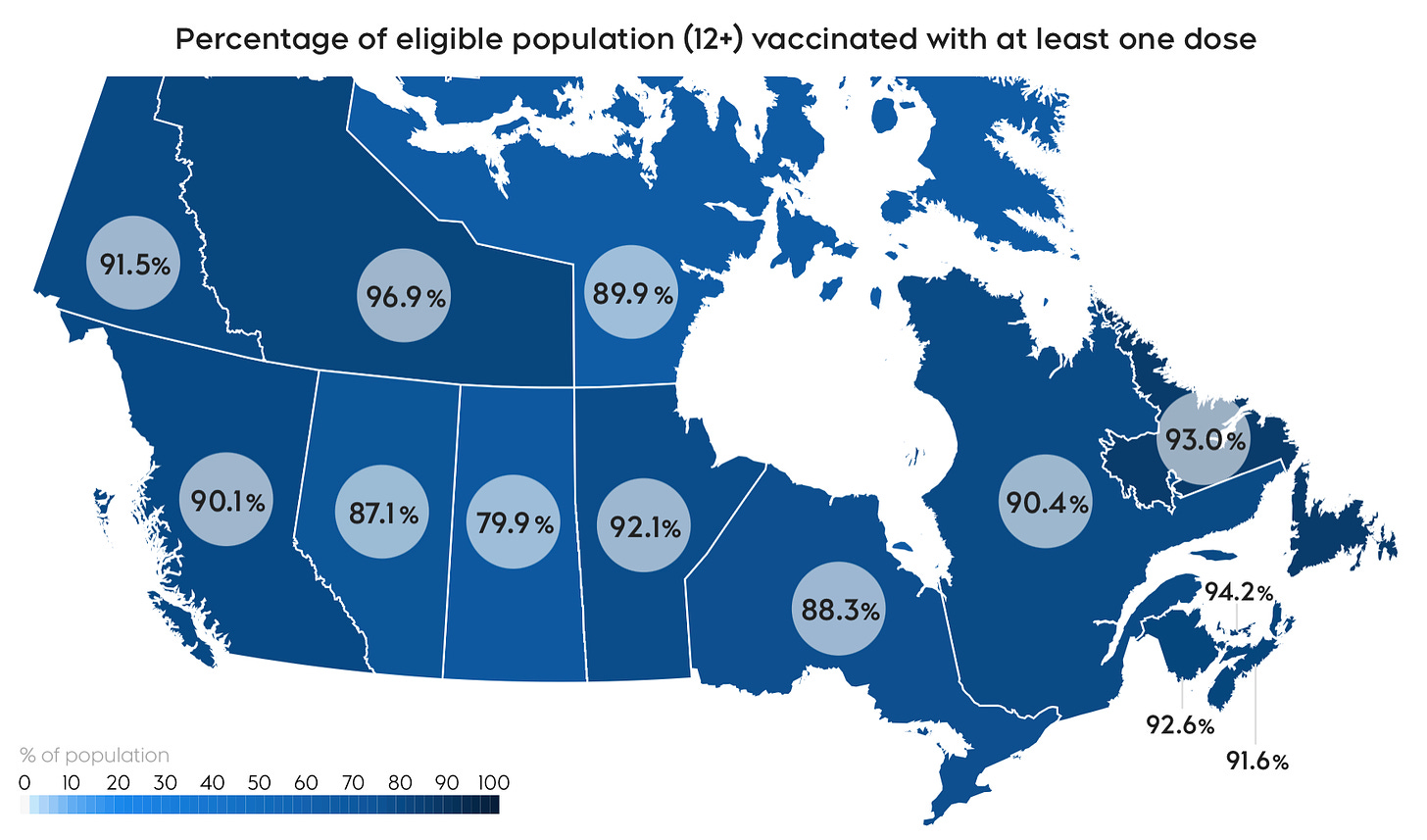🇩🇰
Danish Health Minister Magnus Heunicke says the COVID contact number (reinfection rate or R0) is calculated at 1.1, a slight decline from last week’s 1.2. However, Heunicke says other indicators continue to show a growing epidemic. He says among those 12 years old and older the rate of infections is four times higher among the unvaccinated. Heunicke with a blunt message today: Get vaccinated now!
-
Denmark’s Expert Group for Mathematical Modeling has tabled new calculations for infection activity into December, and it’s not good. Into week 48, the group is projecting increasing case counts and hospitalizations.
By the beginning of December, the panel is estimating that there will be between 2,000 and 4,500 coronavirus cases a day. Most of these infections, it is projecting, will be among unvaccinated people under the age of 60.
Hospitalizations don’t look any more promising, with the panel projecting admissions will be in a range from 60 COVID patients each day to as many as 160. Again, the hospital admissions are anticipated to be mostly among the unvaccinated, except this time it will be among those over the age of 60.
Panel Chair Dr. Camilla Holten Møller:
“Since the previous model calculations, which were published on October 15, we can see that there has been a marked jump in new admissions. This is especially true among those vaccinated and over the age of 70. We can not say exactly what the reason for this leap is. It comes in the wake of the autumn holidays, where you are often closer to the family across generations.”
It is worth noting that in previous calculations the expert panel emphasized it was expecting activity in the weeks ahead to skew towards the lower end of its projected spectrums. In this update, any mention of where they think numbers will tend to go is omitted.
The expert group’s calculations are subject to uncertainty due to variables including whether most people limit social contacts or not. It will table its next calculations in two weeks.
-
Denmark reported 1,457 infections yesterday and then followed it up today with its highest number of new coronavirus cases since January 6, with 1,981. There were no new deaths today.
There were 137,016 total corona tests yesterday, of which 95,775 were PCR tests equaling a very high 2.07% positivity percentage.
-
The number of Danish kommunes with a COVID incidence rate of 100 or more per 100,000 residents has now grown to 80. As you can see the map below is now almost solidly in deep orange and red.
Of those 80 municipalities 13 have an incidence rate of 400 and higher.
-
While the bulk of new infections in the last seven days are among those 20 to 64 years old, there is still a concerning level of infection activity among children. There have been 1,848 cases of COVID among six to 11 year olds in the last week, a number that keeps increasing. The number of infections among toddlers and infants also continues to inch upward, with 182 over the last seven days.
Thankfully hospitalizations among young children remain very low, with just 13 hospital admissions under the age of 19 in the last week. This includes three in the six to 11 year old age group and four who are two years old and younger.
-
COVID hospitalizations overall (255) continued to head upward (+7) while the number of infected people in an ICU (32) also rose (+3) and of those the number on a ventilator (15) inched up as well (+2).
Hospitalizations are now in territory not seen since last February and March.
-
A slight silver lining on the vaccination front yesterday as the number of first vaccine doses administered jumped up to 1,740, the highest number in weeks. Of the 17,068 total inoculations yesterday the lion’s share, 14,106, were booster shots.
To date, 76.4% of the total population has one dose and 75.2% have both shots.
-
The number of breakthrough infections is growing in Denmark. The Staten Serum Institut has tabled its latest report on infections among the fully vaccinated.
Since vaccinations began December 27, it has found, up until week 42, a total of 22,682 breakthrough infections, or 0.5% of all fully vaccinated people in the country. That is an increase from 0.4% in the last update last month. Of those, there have been 862 hospitalizations and 133 deaths.
Department Head Palle Valentiner-Branth:
“Overall, it can therefore be said that the number of breakthrough infections is increasing. However, this was expected because both the number of fully vaccinated and the infection pressure are both increasing. The rising number of breakthrough infections may also be a sign that vaccine efficacy has declined in some populations."
The SSI says that infections among those who have had a booster shot, currently seniors and vulnerable populations, is very low. There have been 77,802 booster doses administered by the end of week 42 with a total of 42 confirmed infections among them.
-
The COVID incidence rate in Brøndy Kommune has shot past 500 per 100,000 residents triggering a number of measures taking effect today to try and wrestle down the infection curve. Everyone in the municipality is urged to get tested. Those that haven’t yet, are also encouraged to go get vaccinated.
It says there is a special focus on daycares and schools because “this is where the infection is high.” Classes or groups are not to mingle including during eating times and in breaks. Parents in the Kommune must drop off and pick their kids outside the school. Students in grade 9 and up who are not vaccinated or have not had a previous coronavirus infection are asked to get tested twice a week.
Schools in Brøndby are also being asked to cancel all major social events. Parents throwing birthday parties for their kids are also asked to keep invitees within their child’s class.
The Kommune is expanding access to vaccinations and opening pop-up testing sites to handle any additional capacity.
The special measures in Brøndby will stay in place until the COVID incidence rate falls below 500 for seven consecutive days.
-
Region Syddanmark is working to reopen closed COVID rapid testing sites. It says there will be anti-gen testing centers in all 22 Southern Denmark municipalities by November 12. Three have already begun operations as of Monday in Odense, Vejle, and Kolding.
Executive Vice President Kurt Espersen
“In the Region of Southern Denmark, Carelink is responsible for performing the rapid tests. Together with the municipalities, they are well on their way to reopening around the region, so that all southern Danes have the opportunity to be tested quickly and can help reduce the infection spread and break chains of infection throughout the autumn and winter.”
The region is also busy hiring staff to help beef up its PCR testing capacity.
As infection numbers climb, Denmark is reintroducing rapid testing across the country. About a month ago, all the rapid testing sites were shut down as Denmark’s once vaunted testing regime downsized.
-
Concerns about local elections are rising along with the infection activity at the National Association of Local Authorities. Voting in municipal elections in Denmark is on November 16. The association is encouraging people to vote by mail in order to lessen the infection risk.
KL CEO Kristian Vendelbo:
“We are interested in getting as high a turnout as possible and creating as much security about the electoral process as we possibly can. So if you are not feeling safe, then you have the opportunity to vote by mail, and you should take advantage of it.”
For their part, municipalities will stock voting sites with hand sanitizer, make sure they are well ventilated, and ensure social distancing between voters.
If you want to vote by mail, you have until November 12 at 4 p.m.
🇸🇪
Sweden has added 3,851 infections and 22 corona deaths since Thursday.
On the vaccination front so far,, 7,255,672 1st vaccine doses (85% of the population 16 years old and older) and 6,915,192 2nd doses (81%) have been administered.
The Swedish Public Health Agency has not updated vaccination statistics for 12 to 15 year olds or for the number of booster shots.
-
The Swedish Public Health Agency has updated national COVID recommendations, which came into effect as of November 1.
For the entire population, whether they are vaccinated or not:
Anyone with respiratory symptoms like a cough, runny nose, sore throat, or a fever should stay home until symptoms clear.
Fully vaccinated people or those who have had a recent infection with symptoms
People must be fever free for at least 24 hours to return to work, school, and other activities.
Who should get tested for COVID:
Anyone who gets symptoms within two weeks after returning to Sweden from a trip to any country outside the Nordics.
Any senior in care or in special housing who develops symptoms
If a person with symptoms needs medical care or treatment
All seniors and health care staff who get sick
Anyone who is contacted as part of a contact tracing effort
Unvaccinated people and those with one vaccine dose:
Stay home if there are any symptoms of a respiratory infection
All adults and children who develop symptoms should get tested and stay home pending a result.
For people that don’t get tested, health authorities advise them to act as if they are infected and isolate for a minimum of seven days.
People in this group can only return to work, school, or other activities when they have been fever-free for 24 hours; feel healthy, and have a negative COVID test.
Preschool Children with symptoms:
The Swedish Public Health Agency does not recommend that children of preschool age be tested for COVID. Children should stay home until they are fever-free for 24 hours.
For anyone testing positive:
Isolate at home for a minimum of seven days.
Return to work, school, or any other activity after seven days of isolation, be fever-free for 48 hours, and feel healthy.
For those without symptoms but who test positive the seven days of isolation begin the day the test was taken.
🇳🇴
Numbers are rising again in Norway as it added 1,961 infections and two virus deaths since yesterday’s update.
COVID hospitalizations (163) are down (-5) while ICU (38) and ventilator numbers (20) are both up (+6 each).
So far, 78.01% of Norwegians 12 years old and older have had one vaccine dose and 69.43% have had both.
-
RS virus rates have more than doubled in just two weeks. The Norwegian Institute of Public Health says RS virus rates have gone from 8% in week 40 to 17% in week 42. The agency says most of the infections are among children four years old and younger. The NIPH says some pediatric wards are reporting “many hospitalized children” and others are under growing pressure due to the rapid increase in cases.
Like in Denmark, and elsewhere, Norway’s national health authority says RS virus infections have come roaring back much earlier than ever before.
As for the reason why:
“This is probably due to the fact that there have been much fewer respiratory infections during the coronavirus restrictions, including RS virus infections, and therefore, that means less natural immunity than normal in the population and especially among young children.”
Parents with very young children are encouraged to call a doctor if their child gets cold and flu symptoms, which then move into the chest resulting in severe bronchitis. Infants battling serious RS virus infections can have a fever, become lethargic, and suffer from strained or difficult breathing.
The NIPH says parents should keep children with respiratory infections at home. They should also ensure others with coughs and colds are away from their young children, even if that person is an older sibling. For added prevention parents should ensure older siblings wash their hands as soon as they come home from school or play for parents with infants.
🇫🇮
After registering 1,460 infections and 12 virus deaths over the weekend it has reported another 807 infections and another three more fatalities in the 24 hours since.
Finland continues to see concerning levels of infection activity.
COVID hospitalizations (226) inched up (+1).
So far, 4,231,745 1st vaccine doses (75.4% of the total population) and 3,883,069 2nd doses (69.4%) have been administered.
-
The Finnish Institute for Public Health is preparing recommendations for vaccinating children under the age of 12. The European Medicines Agency is currently assessing an application from Pfizer/BioNTech to authorize its vaccine for children aged five to 11 years old.
-
The Finnish government is considering expanding its recently introduced vaccine passport system. According to YLE Ministry of Family Affairs and Social Services Krista Kiuru has confirmed her ministry is investigating how to expand the COVID pass requirement. One idea under consideration is putting it in place in areas of the country where there are no restrictions in place.
“A legal assessment will resolve the issue. Then we will find out what the possibilities are in that regard.”
The Finnish Institute for Public Health would also like the COVID pass requirement extended to seniors care homes in order to spur seniors care staff who have not been vaccinated to go get the jab. About 80% of healthcare staff in Finland are fully vaccinated.
🇪🇺🇨🇦💉
The makers of the protein-based COVID vaccine Novavax say they have filed with Health Canada for an authorization of use. If the vaccine is approved for use, it would become the first protein-based coronavirus vaccine in use in Canada. The Canadian government has a deal in place to purchase up to 76 million doses of the vaccine if it is approved for use. Canada also has a deal with Novavax to produce the vaccine at a Montreal-area facility.
The company says it has also submitted all the necessary data to the European Medicines Agency to trigger a rolling review, the first step towards a potential decision to authorize its use. The European Union has an agreement in place for a maximum of 200 million doses of the Novavax vaccine.
🌏💉
A chart by the Financial Times using numbers from Our World in Data is underscoring how truly awful vaccine inequity is in the world. Wealthy western countries have given out more booster shots in the last three months than total vaccinations for the entire year in all developing countries.
🌏
In slightly less than two years, the pandemic’s global death toll is now over 5 million lives lost. The true number of deaths is likely much higher due to under reporting by a number of countries like Russia, for example. COVID is now the third leading cause of death around the world, trailing heart disease and strokes.
🇨🇦
Transport Canada will expand the number of airports that can accept international travelers. For a large chunk of the pandemic, Canada has filtered international travelers through ten airports.
On November 30 that will change with travelers coming from outside Canada being allowed to fly directly into St. John’s International, John C. Munro Hamilton International, Region of Waterloo International, Regina International, Saskatoon John G. Diefenbaker International, Kelowna International, Abbotsford International, and Victoria International.
All those airports are now required to put in screening methods to safely handle international arrivals.
-
Canada reported 1,912 COVID infections and another 53 deaths yesterday.
To date, the Canadian vaccination effort has administered 29,784,232 1st vaccine doses (77.9% of the total population) while 28,312,724 people (74.05%) are fully vaccinated.
In Ontario there were 753 infections in the last 48 hours, of which 456 were among people who were unvaccinated or who had one dose. There are 230 people in hospital and 185 of those patients are unvaccinated or partially vaccinated. Of the 136 in an ICU, that number is 122.
Quebec reported 987 infections and eight more corona deaths in the last 48 hours. The province will ease a number of COVID restrictions on November 15. Among them, dancing will be allowed in bars again and high school students will no longer have to mask up.
In Atlantic Canada, Newfoundland and Labrador reported two cases yesterday but cautioned a cyber attack may be impacting reporting. Nova Scotia has 11 cases. New Brunswick recorded 40 new cases and one more death.
Manitoba saw 469 infections and another three fatalities in numbers covering the weekend and up until today.
There were 234 infections and eight deaths in Saskatchewan over the last two days.
Alberta registered 1,210 infections and another 18 deaths over the weekend including Monday. There are 532 people in hospital, of which 72.7% are unvaccinated or partially vaccinated. Among the other 157 in an ICU, 88.5% are either unvaccinated or have a single dose.
Yesterday B.C. logged 1,370 infections and 25 more corona fatalities covering a three day period over the weekend.




